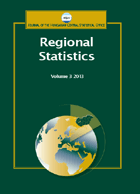Empirical analysis of the distribution of urban parks in Japan
Empirical analysis of the distribution of urban parks in Japan
Author(s): Kenichi ShimamotoSubject(s): Social Sciences, Economy, Geography, Regional studies
Published by: Központi Statisztikai Hivatal
Keywords: urban park; inequality; Japan
Summary/Abstract: As the population of urban areas increases, there is growing concern over the quality of urban environments and parks, which are of strategic importance for the sustainability of the increasingly urbanized society. Urban parks have many important functions thatprovide ecological benefits; human health, well-being, and safety benefits; and economic benefits. These functions correspond to the concept of sustainability and are related to the enjoyment of the basic rights that people intrinsically possess. Therefore, it is desirable for urban parks to be equally distributed amongst the population. This study examines whether the urban park area per capita is equal amongst the regions of Japan, by using various methods applied to Japanese prefectural data from between 1975 and 2015. The results show an increase in urban park area per capita and a relative decreasing trend concerning inequality amongst the prefectures’ inhabitants. However, prefectures with a relatively low area of urban parks per capita remain basically the same.
Journal: Regional Statistics
- Issue Year: 9/2019
- Issue No: 02
- Page Range: 148-172
- Page Count: 25
- Language: English

